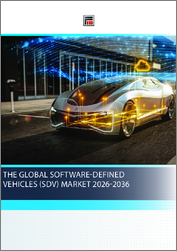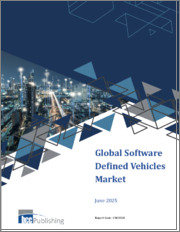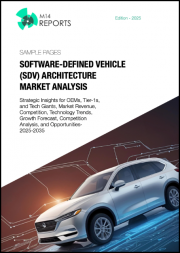
|
시장보고서
상품코드
1745793
인도의 SDV(Software Defined Vehicle) 시장 : 차종별, 추진별, 차량 자율성별, SDV 유형별, 지역별, 기회, 예측(2019-2033년)India Software-Defined Vehicle Market Assessment, By Vehicle Type, By Propulsion, By Vehicle Autonomy, By Software-Defined Vehicle Type, By Region, Opportunities and Forecast, FY2019-FY2033F |
||||||
인도의 SDV(Software Defined Vehicle) 시장은 2026-2033년의 예측 기간 중 CAGR 16.56%를 기록하며, 2025년 26억 9,000만 달러에서 2033년에는 91억 6,000만 달러로 성장할 것으로 예측됩니다. 이 시장은 최근 수년간 괄목할 만한 성장세를 보였으며, 안전과 지속가능한 운송에 대한 인식 증가, 자동차 기술의 급속한 발전, 자동차 기술의 급속한 발전으로 인해 향후에도 계속 확대될 것으로 예측됩니다. 인도 SDV 시장 수요는 전기 및 하이브리드차 생산량 증가, 운전 중 편안함과 편의성에 대한 수요 증가, 자동차의 OTA(Over-The-Air) 시스템 통합 등으로 인해 증가할 것으로 예측됩니다. 성능, 기능, 사용자 경험을 주기적으로 개선할 수 있게 해주며, 딜러를 방문하지 않고도 차량 소프트웨어를 원격으로 진화시킬 수 있게 해줍니다. 최종사용자는 스마트폰과 마찬가지로 시간이 지남에 따라 자동차가 개선되기를 기대하고 있습니다.
또한 OTA 업데이트는 필수적인 안전 강화 및 보안 패치를 신속하게 제공할 수 있습니다. 자동차가 점점 더 연결되고 최신 보안 기능을 갖춘 것으로 확인되어 예측 기간 중 인도 SDV 시장 수요를 촉진하고 있습니다. 또한 인도 정부는 첨단 도로망과 스마트 교통 관리 시스템과 같은 인프라에 대한 투자를 진행하고 있으며, 이는 인도에서 SDV의 성장을 지원하고 있습니다. 또한 이 시장에 진출한 기업은 소프트웨어 업데이트를 통해 새로운 기능을 추가하여 시간이 지남에 따라 차량의 가치를 높이고 있습니다. 주요 시장 참여자들은 시장에서의 입지를 확대하고 SDV 수요 증가에 대응하기 위해 협력하고 있습니다.
예를 들어 BMW AG는 2024년 4월, SDV 분야의 발전을 가속화하기 위해 자동차 소프트웨어 및 비즈니스 IT 솔루션 개발을 위해 Tata Technologies와 협력할 것이라고 발표했습니다.
목차
제1장 프로젝트 범위와 정의
제2장 조사 방법
제3장 미국 관세의 영향
제4장 개요
제5장 고객의 소리
- 브랜드 인지도
- 구입 결정시 고려되는 요소
- 커넥티드카 기능과 인포테인먼트
- 비용 효율
- 솔루션 효율
- 무선(OTA) 업데이트
- 프라이버시와 규제의 고려
제6장 인도의 SDV 시장 전망, 2019-2033년
- 시장 규모 분석과 예측
- 금액별
- 시장 점유율 분석과 예측
- 차종별
- 승용차
- 상용차
- 추진별
- ICE차
- EV
- 차량 자율성별
- 레벨 1
- 레벨 2
- 레벨 3
- 레벨 4
- 레벨 5
- SDV 유형별
- 반SDV
- SDV
- 지역별
- 북부
- 남부
- 동부
- 서부와 중앙부
- 기업별 시장 점유율 분석(상위 5사·기타 - 금액 기반, 2025년)
- 차종별
- 2025년 시장 맵 분석
- 차종별
- 추진별
- 차량 자율성별
- SDV 유형별
- 지역별
제7장 밸류체인 분석
제8장 Porter's Five Forces 분석
제9장 PESTLE 분석
제10장 시장 역학
- 시장 성장 촉진요인
- 시장이 해결해야 할 과제
제11장 시장 동향과 발전
제12장 사례 연구
제13장 경쟁 구도
- 시장 리더 상위 5사의 경쟁 매트릭스
- 상위 5사의 SWOT 분석
- 상위 10사의 주요 기업의 상황
- Aptiv Plc
- Continental AG
- Mobileye Technologies Limited
- Nvidia Corporation
- Robert Bosch GmbH
- Tesla, Inc.
- Waymo LLC
- Qualcomm Incorporated
- ZF Friedrichshafen AG
- Hyundai Mobis
제14장 전략적 제안
제15장 조사회사 소개·면책사항
KSA 25.06.23India software-defined vehicle market is projected to witness a CAGR of 16.56% during the forecast period FY2026-FY2033F, growing from USD 2.69 billion in FY2025 to USD 9.16 billion in FY2033. The market has experienced significant growth in recent years and is expected to maintain an expansion in the coming years owing to enhanced awareness about safety and sustainable transportation, significant technological advancement in vehicles, and the rapidly evolving landscape of automotive technology. The India software-defined vehicle market demand is anticipated to increase owing to the growing production of electric and hybrid vehicles, a rise in demand for comfort and convenience while driving, and an integration of automotive Over-The-Air (OTA) systems. OTA allows automakers to advance vehicle software remotely, enabling regular enhancements in performance, functionality, and user experience without requiring a dealership visit. This capability surges the demand for software-defined vehicles, as end users expect their vehicles to enhance over time, such as smartphones.
In addition, OTA updates also can provide essential safety enhancements and security patches swiftly. As vehicles become increasingly connected, confirming they are featured the latest security features, propelling the India software-defined vehicle market demand in the forecast period. Furthermore, the Indian government is investing in infrastructure including advanced road networks, and smart traffic management systems, supporting the growth of software-defined vehicles in India. Also, companies in the market are increasing the value of the vehicle over time as new features are added via software updates. Key participants in the market are collaborating to expand their market presence and address the rising demand for software-defined vehicles.
For instance, in April 2024, BMW AG announced to collaboration with Tata Technologies for the development of automotive software and business IT solutions to accelerate the progress in the field of software-defined vehicles.
Electrification of Vehicle Drives the India Software-Defined Vehicle Market Growth
The significant shift towards electrification is a key driver in India software-defined vehicle market. The government of India formed different initiatives, including the Faster Adoption and Manufacturing of Hybrid and Electric Vehicles (FAME) scheme, which are motivating automakers to introduce electric vehicles featured with advanced software. This transition not only minimizes emissions but also improves vehicle performance and user experience, driving the India software-defined vehicle market growth. Moreover, the growing awareness among consumers about sustainable options, accelerating the integration of electric vehicle technology into software-defined vehicles is projected to surge, fostering innovation and market growth. In addition, companies in the market are considerably investing in software solutions that manage regenerative braking, battery effectiveness, and advanced charging infrastructure. Furthermore, market participants in the market are efficiently launching different intelligent centers to help manufacture advanced software-defined vehicles.
For instance, in March 2023, BlackBerry Limited announced the launch of an IoT center of excellence in India for embedded software engineers to support building the next generation of software-defined vehicles.
Integration of Advanced Driver Assistance Systems (ADAS) Pushes the India Software-Defined Vehicle Market Demand
The integration of ADAS is gaining prevalence in India software-defined vehicle market owing to rising government regulations on road and vehicle safety and growing consumer awareness. Features including lane-keeping assistance, adaptive cruise control, and automatic emergency braking are becoming a significant market trend. Automakers are integrating advanced software systems to advance these functionalities, improving vehicle safety, the overall driving experience of end users and enhancing user comfort. The demand for vehicles equipped with ADAS is probably to rise because road safety is becoming a priority among consumers. In addition, collaborations between tech companies and automakers are propelling advancements in this domain, leading to fully autonomous driving capabilities, which further propel the India software-defined vehicle market demand in the forecast period.
For instance, in July 2024, Tata Technologies announced the collaboration with Arm Limited to drive innovation in software-defined vehicles and reduce the development time of software-defined vehicles for automotive OEMs.
Passenger Cars Dominate India Software-Defined Vehicle Market Share
Passenger cars dominate the market growth owing to the increasing production of passenger cars in emerging countries, rising disposable incomes, and rapid urbanization. The software-defined passenger car demand in India is projected to accelerate owing to a growing demand for smart and connected features in vehicles, significant technological advancements, and rising awareness and requirement for advanced driver-assistance systems in automobiles. Also, innovations in software and hardware are making it easier for automakers to integrate advanced technologies into passenger cars, making them more appealing to buyers. Additionally, government initiatives focused on promoting electric vehicles and advanced technologies are often aimed at passenger vehicles, motivating manufacturers to invest in software-defined vehicle capabilities, which further drive the software-defined passenger cars in India. Companies in the market are launching passenger cars with the integration of different software and hardware to address the rising demand for advanced and connected passenger cars.
For instance, launched in June 2025, the Tata Harrier EV is a significant example in passenger car segment, showcasing the integration of software-defined vehicle capabilities. It comes equipped with a level-2 ADAS suite that includes features such as adaptive Cruise Control, driver attention warning, auto park assists.
Aftermarket is Expected to Register Significant Market Share in the India Software-Defined Vehicle Market
Aftermarket is projected to hold a significant market share in the Indian market for software-defined vehicles owing to increased demand for vehicle connectivity, rapid trend of personalization, rising requirements for upgrading their existing vehicles, and stringent government rules and regulations. As automakers are introducing more advanced vehicles, owners look for advancements and upgrades rather than new purchases, leading to higher requirements for aftermarket solutions. Constant software updates for road and vehicle safety, navigation, and infotainment systems features will further boost India automotive aftermarket market growth. The significant surge in electric vehicles introduces different market growth opportunities for market players. In addition, the partnership between tech companies and automotive manufacturers will foster innovation in aftermarket services.
For instance, in April 2024, Tata Technologies announced to formation of a joint venture with BMW AG to introduce an automotive software and IT hub in Pune, Bengaluru, and Chennai. The joint venture will focus on strategic software development, including solutions for software-defined vehicles, digital services in the aftermarket, automated driving, and infotainment systems.
Key Players Landscape and Outlook
To enhance their market reach and offerings, Indian software-defined vehicle companies are embracing next-gen technologies like over-the-air (OTA) updates and autonomous driving systems. These software-driven advancements improve vehicle performance, safety, and user experience while enabling faster feature upgrades. By prioritizing a software-first approach, these firms can swiftly adapt to industry changes and roll out innovations. Strategic alliances with global tech leaders and increased R&D investments further help them stay competitive and address shifting consumer needs. As a result, they not only solidify their market standing but also drive greater customer engagement and brand loyalty.
For instance, in October 2024, Hyundai Motor Company, Kia Corporation, and Samsung Electronics announced a partnership to connect software-defined vehicle to smartphones and introduce a new mobility experience for customers.
Table of Contents
1. Project Scope and Definitions
2. Research Methodology
3. Impact of U.S. Tariffs
4. Executive Summary
5. Voice of Customers
- 5.1. Brand Awareness
- 5.2. Factors Considered in Purchase Decisions
- 5.2.1. Connected Car Features and Infotainment
- 5.2.2. Cost-Effectiveness
- 5.2.3. Efficiency of Solutions
- 5.2.4. Over-the-Air (OTA) Updates
- 5.3. Consideration of Privacy and Regulations
6. India Software-Defined Vehicle Market Outlook, FY2019-FY2033F
- 6.1. Market Size Analysis & Forecast
- 6.1.1. By Value
- 6.2. Market Share Analysis & Forecast
- 6.2.1. By Vehicle Type
- 6.2.1.1. Passenger Vehicle
- 6.2.1.2. Commercial Vehicle
- 6.2.2. By Propulsion
- 6.2.2.1. Internal Combustion Engine Vehicle
- 6.2.2.2. Electric Vehicle
- 6.2.3. By Vehicle Autonomy
- 6.2.3.1. Level 1
- 6.2.3.2. Level 2
- 6.2.3.3. Level 3
- 6.2.3.4. Level 4
- 6.2.3.5. Level 5
- 6.2.4. By Software-Defined Vehicle Type
- 6.2.4.1. Semi-Software-Defined Vehicle
- 6.2.4.2. Software-Defined Vehicle
- 6.2.5. By Region
- 6.2.5.1. North
- 6.2.5.2. South
- 6.2.5.3. East
- 6.2.5.4. West and Central
- 6.2.6. By Company Market Share Analysis (Top 5 Companies and Others - By Value, FY2025)
- 6.2.1. By Vehicle Type
- 6.3. Market Map Analysis, FY2025
- 6.3.1. By Vehicle Type
- 6.3.2. By Propulsion
- 6.3.3. By Vehicle Autonomy
- 6.3.4. By Software-Defined Vehicle Type
- 6.3.5. By Region
7. Value Chain Analysis
8. Porter's Five Forces Analysis
9. PESTLE Analysis
10. Market Dynamics
- 10.1. Market Drivers
- 10.2. Market Challenges
11. Market Trends and Developments
12. Case Studies
13. Competitive Landscape
- 13.1. Competition Matrix of Top 5 Market Leaders
- 13.2. SWOT Analysis for Top 5 Players
- 13.3. Key Players Landscape for Top 10 Market Players
- 13.3.1. Aptiv Plc
- 13.3.1.1. Company Details
- 13.3.1.2. Key Management Personnel
- 13.3.1.3. Products and Services
- 13.3.1.4. Financials (As Reported)
- 13.3.1.5. Key Market Focus and Geographical Presence
- 13.3.1.6. Recent Developments/Collaborations/Partnerships/Mergers and Acquisition
- 13.3.2. Continental AG
- 13.3.3. Mobileye Technologies Limited
- 13.3.4. Nvidia Corporation
- 13.3.5. Robert Bosch GmbH
- 13.3.6. Tesla, Inc.
- 13.3.7. Waymo LLC
- 13.3.8. Qualcomm Incorporated
- 13.3.9. ZF Friedrichshafen AG
- 13.3.10. Hyundai Mobis
- 13.3.1. Aptiv Plc
Companies mentioned above DO NOT hold any order as per market share and can be changed as per information available during research work.



















